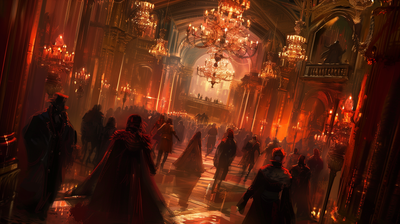This is Part 2 in my series of how I plan roleplay heavy D&D campaigns. For the rest of the posts in this series, click the button and return to the index.
The players and their characters
Once I’m satisfied with the setting, I stop my own development on the campaign. Now I turn it over to the players. I send them a link to a LegendKeeper (a world building wiki tool) with all the information on the setting, and I ask them to make characters.
I set the expectation that these characters should be richly intertwined with the setting. Their backstories don’t need to be long, but they need to have depth. I give them these questions to answer to guide the process:
- Who is your character? How did they come to be an adventurer?
- Who in this world do they know? What friends, family, lovers or enemies do they have?
- What are their goals? How do you (the player) want this character to evolve?
- What tensions or open plot hooks does your character have? There should be a handful of open-ended issues that I can tie into my world.
- What does a day-in-the-life of your character look like when they’re not adventuring? What job do they have?
- How does your character know the other characters? Why would your character risk their life for any of the other characters?
Some players send me 2-3 pages of content. Others send me a couple of paragraphs. It’s not the amount of content they come up with, but the depth of it. There needs to be places I can hook them into my world. If the character is flat, I can’t do it.
This is an iterative process. The players will send me some info, and I’ll ask questions, or prod them. Or I’ll notice something that, if we tweak it just a little, really fits into my setting much better. We go back and forth on it a few times and then say that it's good enough. All of this happens before the Session 0 - for my campaigns I expect players to come to the Session 0 with a fully fleshed out character.
Here are the characters that came out of planning for Shadows Over Siqram
Izzy - the 250 year old elf retired dragon rider. She spent her early years as part of Siqram’s army, and her later years as a mentor to orphaned kids of Siqram. Her wife is dead and she dedicates her social work to her wife’s name.
Kayson - the ranger/cleric/thief/fighter that runs a vet clinic in the city. She’s got god issues and isn’t sure the deity she’s sworn to is the right one for her anymore.
Ash - echo knight; the son of the previous head of Siqram’s army. Ash’s dad died unexpectedly. Ash’s mom is cold. He’s in a position of command, but everyone thinks he’s a nepo-baby. He wants to prove himself to the city.
Arranis - warlock; works for the Merchant’s Guild as a treasure hunter (non-binary Indiana Jones vibes). Is fey, but doesn’t remember when they came to this realm… and can’t get back. They want answers.
Now I’ve got a kernel of an idea, a place it happens in and a bunch of characters that are ready to be integrated into a campaign.
With all that in place, I shift my focus to my villain’s agenda.
The villain and the plan
The next phase is figuring out who the antagonist is, and what it is they’re doing. A common mistake here is DMs will start trying to write a plot. “The players will get mugged, and realize the muggers were from a cult. Then they’ll track down the cult and find a hidden manuscript in the cult’s lair. Then they’ll use that manuscript…” and on and on. The problem with this is that you’re scripting the players actions. And that’s no good.
The key here is to come up with the villain and the plan. I got this idea from Guy Schlander’s book, The Practical Guide to Becoming a Great GM. In it he gives the formula for a villain’s plan:
Someone wants something by sometime using some tools, but is having trouble getting it because of reasons.
This can really be absolutely anything. For Siqram, I had a couple of newer D&D players, so I wanted to give them a fairly standard D&D antagonist. I wanted a devil. And what do devils do? They collect souls.
Here was my first iteration:
Some devil wants souls by some time using a cult in the city of Siqram, but is having trouble getting it because of reasons.
And this is where the iterative nature of planning a campaign comes in. I was really stuck on “why is this devil having a hard time?” There were a lot of points in this process where I got stumped, and I used a couple of tools to get out of them.
The first was my extremely patient spouse, who let me bounce ideas off her over and over.
The other big tool for me was ChatGPT, which is really contentious in this space. There’s a lot to say about ChatGPT (I’d love to write something about this in the future), but what I’ll say here is that I find it most useful when I tell it to act as an editor and to ask me probing questions instead of generating ideas.
For this particular stumping, I started trying to daydream about Siqram and how it might defend itself. I asked myself: how has this high magic, high fantasy city survived for so long? With so much magic, it must have a lot of wealth. And with a lot of wealth, all manner of creature would assault it constantly. And I really honed in on that idea of magic. What would a city with so much magical power do to defend itself? My partner provided the answer. “Don’t they just have some magic shield or something?” It was a huge lightbulb! Of course they do!
But, then I started to wonder; how did they get it? And why? I already had my answer in my short setting summary from before. In order to keep the red dragons out, they built a massive shield that surrounded the entire city. This shield isolated the city, but it also protected it. No being that had obvious ill will towards the city could enter or be summoned into the city. That’s a pretty big barrier.
Now I have:
Some devil wants souls by some time using a cult in the city of Siqram, but is having trouble getting it because the city is protected by a massive shield.
The last piece to come up with was the time pressure. If a villain doesn’t have a ticking clock, it has no reason to act – and we want our villain to act. If the villain doesn’t act, there is no campaign. So, why would my devil be under time pressure?
Well, what if there was some sort of devil proceeding coming up? Devils love their rules and contracts, after all. What if this devil wanted a promotion? And the way to do that was by collecting souls? It needs to collect enough souls before the next proceeding.
And boom! We have a plan:
Zakaroth the Ascendant wants to harvest the souls of Siqram before the next Conclave of Hell using a cult in the city, but is having trouble getting it because the boundary glyph keeps the city safe.
This plan is a basic outline and a motivator for everything that comes next. It asks a million questions that beg to be answered, and that’s the next step.
The plan has steps
In this part of the process, I channeled my villain. I tried not to think about the players, or what I wanted to have happen as a DM. Instead, I thought about my villain’s motivations. How do they plan? How do they act? Are they brash? Are they conniving? I really tried to put myself in their shoes, and plan out their master plan.
Fortunately for us, that one sentence plan isn’t enough to go off of. Zakaroth needs to break his plan down into steps.
The first issue for Zakaroth is the boundary. He needs to find some way of getting around it. He’s from the plane of Hell, and he needs to be summoned to the material plane. If the boundary is up, he can’t be summoned into the city, and he’s not strong enough to outright destroy the boundary. So he’s got to figure out a way to remove it.
And it's this kernel of an issue that drove my entire campaign.
I decided that Zakaroth was a very, very cunning devil. He wanted to destroy the boundary in epic fashion. And he wanted to do this by tricking the PCs into doing the destroying. This would give him a spectacular, devastating victory over the heroes.
His plan was to steal a boundary glyph, corrupt it, and trick the players into recovering it and re-inserting it.
But even that isn’t enough of a plan. How is he going to steal a glyph? They’re super powerful, and certainly he would be noticed.
Well, he’ll make a diversion. What if he could weaken the boundary just enough to be able to summon some minor demons into the city. These demons would wreak havoc on a city that isn’t used to issues like this. And maybe, in that chaos, he could steal an entire glyph.
But how does he weaken the boundary? Well, here I just used some hand-wavy demonic mumbo jumbo and said “the cult has some infernal magic that can temporarily poison a boundary glyph which will weaken the entire boundary”. This is the great thing about being a GM - you can decide what needs a deep technical reason and what doesn’t!
So this is what his plan looked like:
- Weaken a single glyph with infernal magic
- Create a distraction in the city by summoning minor demons all throughout the city while the glyph is weakened
- Steal a glyph while the city is distracted
- Poison/corrupt the stolen glyph, and leave it someplace where it can be found
- When the corrupted glyph is re-inserted into the boundary, it will destroy the entire boundary
- Get summoned into the city and eat all the souls
And boom. Now we have a detailed plan. In this campaign, because Zakaroth was such a cunning NPC, I had him create diversions and backups to each step of the plan. For example, while step three was happening, he had his cult start a powerful ritual within the city. The PCs couldn’t stop both. By the end of the campaign, the PCs really hated this guy, and consistently felt a step behind. He really came to life.
Next up I talk through how I integrate the characters into the story and outline the campaign







